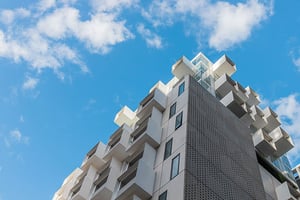Discover expert tips and strategies for investing in multifamily real estate that will help you...
Estimating Maintenance Expenses for Multifamily Property: A Comprehensive Guide
Learn how to effectively estimate and manage maintenance expenses for multifamily properties with this comprehensive guide.
Understanding the Importance of Estimating Maintenance Expenses

Estimating maintenance expenses is a crucial aspect of managing multifamily properties. By accurately estimating these costs, property owners and managers can effectively budget for maintenance and ensure that the property remains in good condition. Without proper estimation, maintenance costs can quickly spiral out of control, leading to financial strain and potential neglect of necessary repairs.
One of the key reasons why estimating maintenance expenses is important is that it allows for proactive planning. By understanding the potential costs associated with maintenance, property owners can set aside funds and allocate resources accordingly. This ensures that there are no surprises when it comes to repairs and maintenance tasks, and helps prevent any disruptions to the tenants' daily lives.
Additionally, estimating maintenance expenses also allows property owners to prioritize repairs based on urgency and importance. By knowing the estimated costs, owners can determine which repairs need immediate attention and which can be delayed or scheduled for a later date. This helps in managing resources efficiently and ensures that the property is well-maintained without overspending on unnecessary repairs.
Overall, estimating maintenance expenses is an essential step in effectively managing multifamily properties. It provides property owners with the necessary information to plan, budget, and prioritize repairs, ultimately leading to cost savings and improved tenant satisfaction.
Factors to Consider when Estimating Maintenance Costs
When estimating maintenance costs for multifamily properties, there are several factors that need to be taken into consideration. These factors can greatly influence the overall expenses and should be carefully evaluated to ensure accurate estimation.
One of the primary factors to consider is the age and condition of the property. Older properties may require more frequent repairs and maintenance compared to newer ones. Additionally, properties in poor condition may have higher maintenance costs due to the need for extensive repairs and renovations.
The size and layout of the property also play a significant role in estimating maintenance costs. Larger properties generally have higher expenses as they require more materials and labor for maintenance tasks. Similarly, properties with complex layouts or unique features may have specialized maintenance requirements, leading to increased costs.
Another factor to consider is the location of the property. Different regions may have varying costs for materials and labor, which can impact maintenance expenses. It's important to research and account for local market rates when estimating costs.
Lastly, the type of multifamily property can also affect maintenance costs. For example, a property with amenities such as a swimming pool, fitness center, or landscaped gardens may have higher maintenance expenses compared to a property without these features. Understanding the specific needs and requirements of the property is essential in accurately estimating maintenance costs.
Methods for Estimating Maintenance Expenses
There are several methods that can be used to estimate maintenance expenses for multifamily properties. Each method has its own advantages and considerations, and property owners should choose the approach that best suits their needs and preferences.
One common method is to calculate maintenance costs as a percentage of the property's overall operating expenses. This approach involves determining the percentage of operating expenses that can be attributed to maintenance and applying it to the property's budget. This method provides a simple and straightforward estimation, but it may not account for specific maintenance requirements or variations in costs.
Another method is to conduct a thorough inspection of the property and create a detailed inventory of maintenance needs. This approach involves assessing each area of the property, identifying potential repair and maintenance tasks, and estimating the costs associated with each task. This method provides a more accurate estimation but requires a significant amount of time and effort.
Additionally, property owners can also consult industry benchmarks and guidelines to estimate maintenance expenses. These benchmarks provide average costs for different maintenance tasks and can serve as a starting point for estimation. However, it's important to consider the specific characteristics of the property and make adjustments accordingly.
Ultimately, the chosen method for estimating maintenance expenses should align with the property owner's goals, resources, and level of detail required.
Creating a Maintenance Budget for Multifamily Properties
Creating a maintenance budget is a crucial step in effectively managing maintenance costs for multifamily properties. A well-planned budget ensures that there are sufficient funds allocated for repairs and maintenance tasks, preventing any financial strain or delays in necessary repairs.
To create a maintenance budget, property owners should start by assessing the estimated maintenance expenses based on the factors discussed earlier. This provides a baseline for budgeting and helps in determining the overall allocation of funds.
Next, it's important to prioritize maintenance tasks based on urgency and importance. Some repairs may require immediate attention to prevent further damage or ensure tenant safety, while others can be scheduled for a later date. By categorizing repairs and prioritizing them accordingly, property owners can allocate funds more effectively.
Property owners should also consider setting aside a contingency fund within the maintenance budget. This fund acts as a buffer for unexpected repairs or emergencies and helps in managing unforeseen expenses without disrupting the overall budget.
Regular monitoring and review of the maintenance budget is essential to ensure its effectiveness. Property owners should track actual expenses, compare them to the budgeted amounts, and make adjustments as necessary. This helps in identifying any areas of overspending or underspending and allows for timely corrective actions.
By creating a well-planned maintenance budget, property owners can effectively manage maintenance costs, ensure timely repairs, and maintain the value and condition of their multifamily properties.
Tips for Efficiently Managing Maintenance Costs
Efficiently managing maintenance costs is key to ensuring the financial health and sustainability of multifamily properties. By implementing effective strategies and practices, property owners can minimize expenses and optimize the maintenance process.
One important tip is to prioritize preventive maintenance. Regular inspections and proactive repairs can help identify and address potential issues before they escalate into costly repairs. This not only reduces expenses but also extends the lifespan of the property's components and systems.
Another tip is to establish strong relationships with reliable contractors and service providers. Building a network of trusted professionals ensures timely and cost-effective repairs, as well as access to specialized expertise when needed. Property owners should research and select contractors based on their track record, qualifications, and pricing.
Implementing a maintenance tracking system can also greatly aid in managing costs. This system allows property owners to keep track of maintenance tasks, schedule regular inspections, and monitor expenses. By having a centralized database of maintenance history, property owners can identify patterns, track costs, and make informed decisions regarding repairs and budgeting.
Regular communication with tenants is essential in managing maintenance costs. Encouraging tenants to report maintenance issues promptly can help address problems before they worsen, preventing costly repairs. Additionally, providing clear guidelines and expectations regarding tenant responsibilities for maintenance can help minimize unnecessary expenses.
Lastly, property owners should regularly review and update their maintenance processes and procedures. By identifying areas for improvement and implementing more efficient practices, owners can optimize the use of resources and reduce costs over time.
By following these tips, property owners can effectively manage maintenance costs, minimize expenses, and ensure the long-term success of their multifamily properties.


